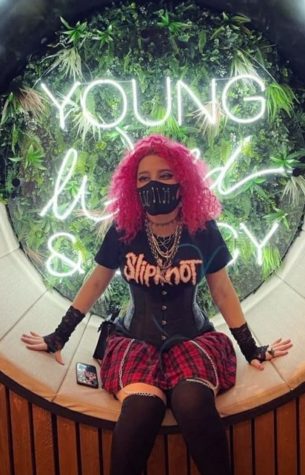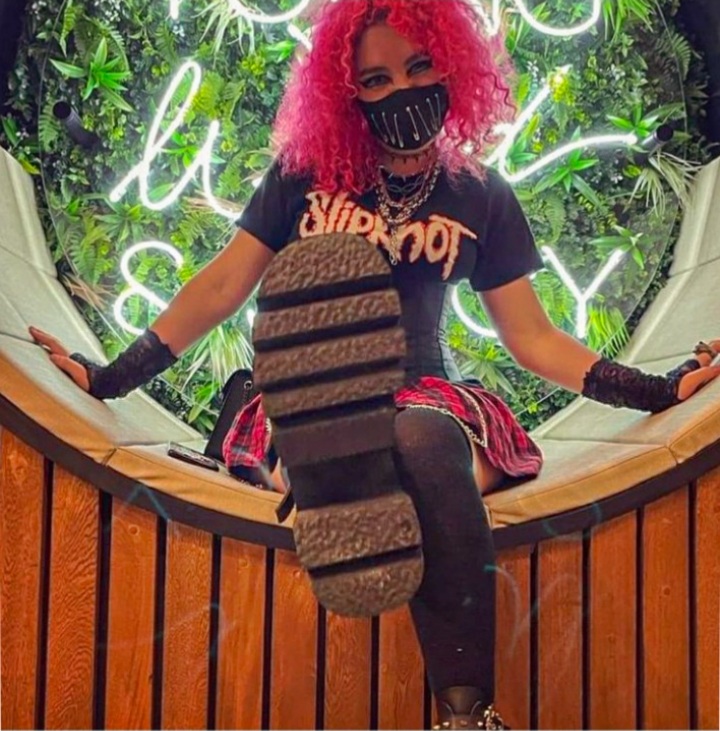Amalia Garcia Pays a Price For Being Herself
Amalia Garcia, 9th grade student, Amsterdam Plaza with her friends on September 2, 2021.
She wears Dr. Marten boots, baggy pants with white outlines, and chains on the side of her hips. Above this, is an astronomy shirt covered in stars, along with a black waist corset, black lace gloves, silver chains. On her face, black eyeliner that makes her eyes pop, and a black facemask adorned with safety pins, along with bleached blonde, curly, fluffy hair.
New fashion styles have been brought to TCS by a couple of 9th-grade students, one of them being Amalia Garcia. Bringing these new styles to high school has not been easy as she has to deal with the criticism and reactions from other high school students.
“There is a lot of stigma around people that dress differently, especially in school,” Garcia said.
But different is not always seen as good. This stigma has led to bullying in middle and high school.
She has gotten alcohol thrown at her, along with food, been yelled at in the hallways and parking lot. There have been insulting rumors and chisme along with intrusive questions about her personal life.
“I’ve gotten water sprayed up. Alcohol, not drinking, but the gel. I’ve gotten thrown out like it’s just a bunch of stuff that bothers me but at the same time, I’m over it,” Garcia said.
The motivation in dressing alternatively in school, despite the negative commentary, is for Amalia to express herself freely; to be happy. Normally, everyone is looking to achieve the goal of happiness, and she is paying the price by dealing with other students’ opinions.
“I think the experience is partially positive. It makes me feel like myself when I dress the way I dress or dye my hair and do my makeup. I feel good when I find people that dress however they want,” Garcia said.
When she wakes up, she chooses the base layer of her outfit and starts the process. The way she chooses her outfit depends on her mood. If she is tired then she will wear fewer things most likely be in some sweatpants and a t-shirt. But when she is in a good mood and feeling good about herself, she will put more effort into her appearance and will wear the outfits that express her style.

After choosing her base layer, Garcia will get her breakfast and then complement the outfit with rings, chains, gloves, or fishnets. In school, some days are better than others and nothing bad happens, but other someone says or does something and puts her in an unhappy mood.
Along with the bullying she is also stereotyped a lot because of the alternative style she carries. Some of the stereotypes are mostly that she has depression, horrible mental health, and everything she does or wears has a deeper meaning. People believe that because she is dressed in black, she has self-destructive behaviors that cause them to think that she is unapproachable. This is offensive for Garcia because it’s her life, her business, and “some people treat it as gossip.” It is a stereotype that can be very overwhelming since Garcia has friends with the same style and they are the nicest people she’s met, huge advocates for everything and she doesn’t want them to get those same assumptions.
“They (other students) will talk to me about stuff that I don’t want people to know. It’s my personal life, my mental health. There’s no reason why everyone should know about it,” Garcia said.
Part of the high school experience is wanting to fit in and have a group of friends, drama, etc, but when you don’t fit in, you get criticized by everyone. So when people want to know more about her mental health, they don’t realize that they affect it by making fun of her and excluding her.
“It takes a toll on you when you know people are talking about you or making fun of you behind your back. I’ve seen some people play Pictionary with my face. So it’s kind of knowing that people are staring at me. It’s kind of weird, some kind of self-consciousness of what I do and how I dress and how I look. So being the way I am, makes me happy but it also makes me insecure,” Garcia said.
Once Garcia realized that these types of responses aren’t gonna go away, she thought “might as well make it a joke.” Not only is she treated like this in school but also outside in public places like the mall with her family.
“Sometimes we have my mom play this game where we try and count how many people will stare at me rudely at malls. So it’s pretty funny to do that.”
Meanwhile, she’s making it a joke, her confidence and self-esteem are and now every time someone says something rude about her she just dismisses them. “If someone says something rude about me or how I dress or how I do my makeup, honestly, like it’s their fault I’m sorry, did you don’t like yeah, I don’t care. You don’t like me? I don’t care. It’s a certain point where I just learned to love the way I look and gain my confidence,” Garcia said.
Despite having her confidence and not caring, she does want people to talk to her. So to fix the unfriendly image she has been set with by other people, she proves the stereotype wrong and decides to be the nicest person ever. “She is an amazing English student and she’s got a great personality and a great attitude,” Emily Butterworth, 9th grade English teacher, said.
People don’t get these types of ideas of Garcia just because; there is a science behind how people dress affect the way they are perceived.
“Clothes affect our behavior and our moods because of the symbolic meaning that we (as a society) ascribe to different types of attire,” BrainFodder said
Psychologist World says in early civilizations the purpose of clothing was to keep us warm, and helped us with general survival. Now clothes have developed as an important asset to our social lives; they affect the way we see ourselves. They can help us be seen and be used as a distraction from our personalities and personal wealth along with taste.
The stigma created by the school over her style and her assumptions about her life may be hard sometimes but it has also let her develop more confidence and strength. It created a shell that protects her from the comments made and thrown at her. She has persevered throughout and has created many friendships that appreciate her style and how she decides to express herself.
Work Cited:
- “Fashion Psychology: How The Clothes You Wear Affect How People Perceive You.” Fashion Psychology, 19 Feb. 2016. https://www.psychologistworld.com/body-language/psychology-of-clothing-dating-dress
- “7 ways your clothes change the way you think.” Brain Fodder, 17 June.2016. https://brainfodder.org/psychology-clothes-enclothed-cognition/
- “Dress, body, and self: research in the social psychology of dress – Fashion and Textiles.” SpirngerOpen, 22 Nov.2014. https://fashionandtextiles.springeropen.com/articles/10.1186/s40691-014-0020-7




